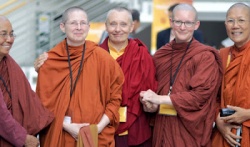Ayya
It is most commonly used as a veneration in addressing or referring to an ordained female Buddhist monk, most often of the Theravadan tradition in southeast Asia. It is sometimes mistaken as equivalent to Christian use of the word, "sister." Ayya can refer to either a Bhikkhuni (fully ordained and usually wearing orange or yellow robes in southeast Asia) or a Samaneri (shramanerika) ten-precept novice renunciant or a Sikkhamana (wearing white, brown or sometimes pink), but not to non-ordained precept-holders.
Generally for bhikkhunis, robes would be maroon with yellow in Tibet; gray (for Mahayanans) or orange/yellow (for Theravadans) in Vietnam; gray in Korea; gray or black in China and Taiwan; black in Japan; orange or yellow in Thailand, Sri Lanka, Nepal, Laos, Cambodia and Burma. The colour of robes distinguishes both level of ordination and tradition, with white (usually worn by a male renunciant before ordination) or pink symbolising a state of ambiguity, being on the threshold of a decision, no longer secular and not yet monastic. A key exception to this is in the countries where women are not allowed to wear robes that signify full ordination, Cambodia, Laos, Thailand and (Theravadans in) Vietnam. So, the majority of Ayyas wear orange/yellow or white/pink.
Re-establishment of Bhikkhuni Lineage
There are very few fully ordained (Bhikkhuni) Ayyas in the 21st century because the Theravadan nuns' lineage was lost in most of southeast Asia, over the last 1,000 years. The Theravadan Bhikkhuni lineage was reinstated in 1996 at Sarnath, India, by a quorum of Theravada monks and Korean nuns. Eleven Sinhalese dasa sil mata nuns took full Bhikkhuni ordaination in that ceremony, reviving the Theravada Bhikkhuni Order after 980 years of decline and dissipation. Theravadan ordination is available for women (as of 2006) in Sri Lanka, where many of the current bhikkhunis have been ordained. The ordination process has several stages, which can begin with Anagarika (non-ordained) precepts and wearing white robes, but is as far as many women are allowed to take their practice. In Thailand, where it is illegal for women to take ordination, nearly all female monastics are known as mae chees (also spelled "Mae ji)," regardless of their level of attainment.
As awareness of the need for ordained women to study and practice grows, so does the support for female monks. There are very few places for an Ayya to reside, once she ordains. The number of monasteries and viharas for women is still very small but beginning to increase.
